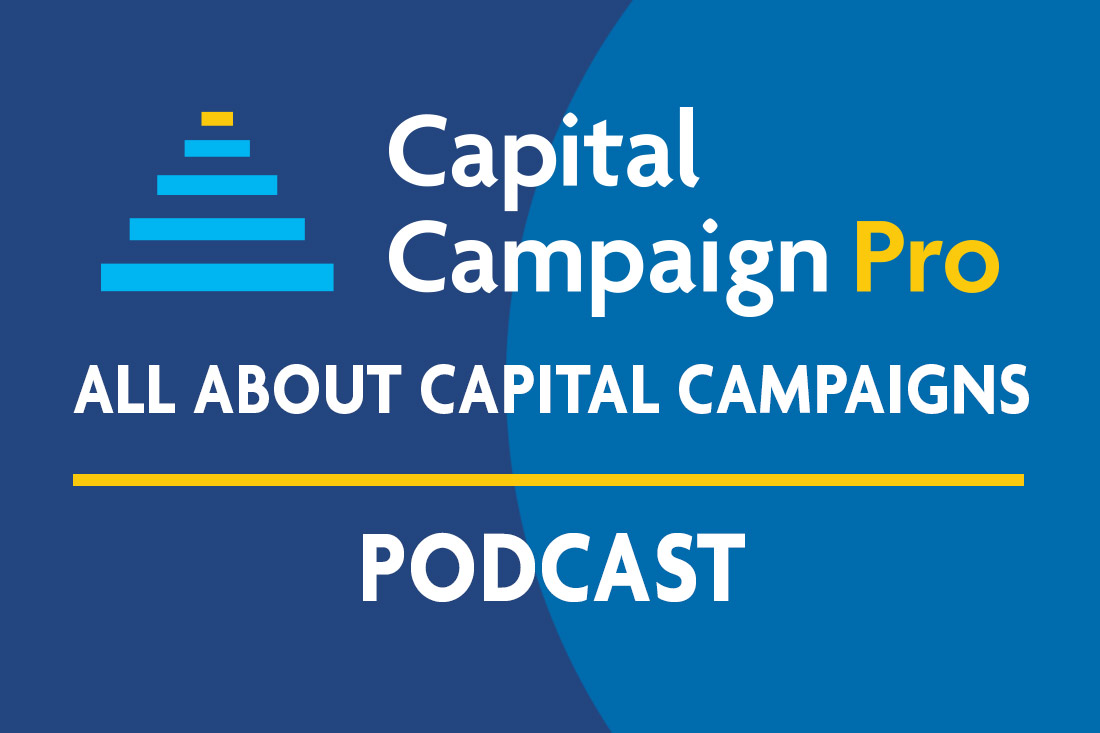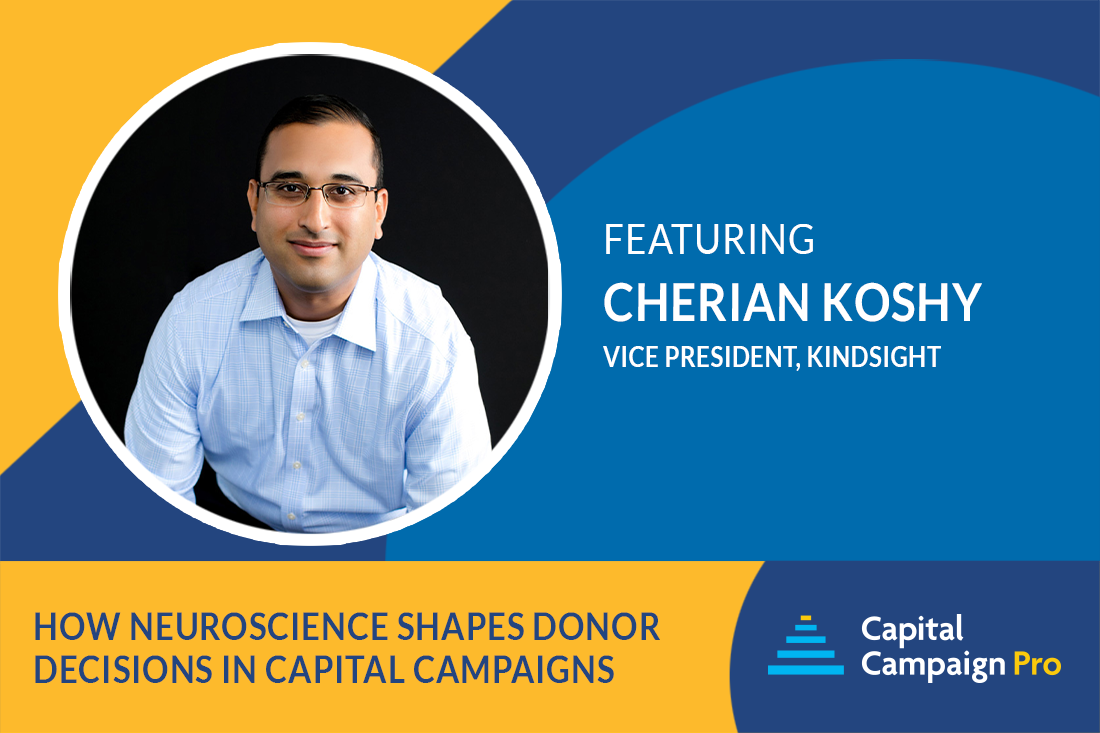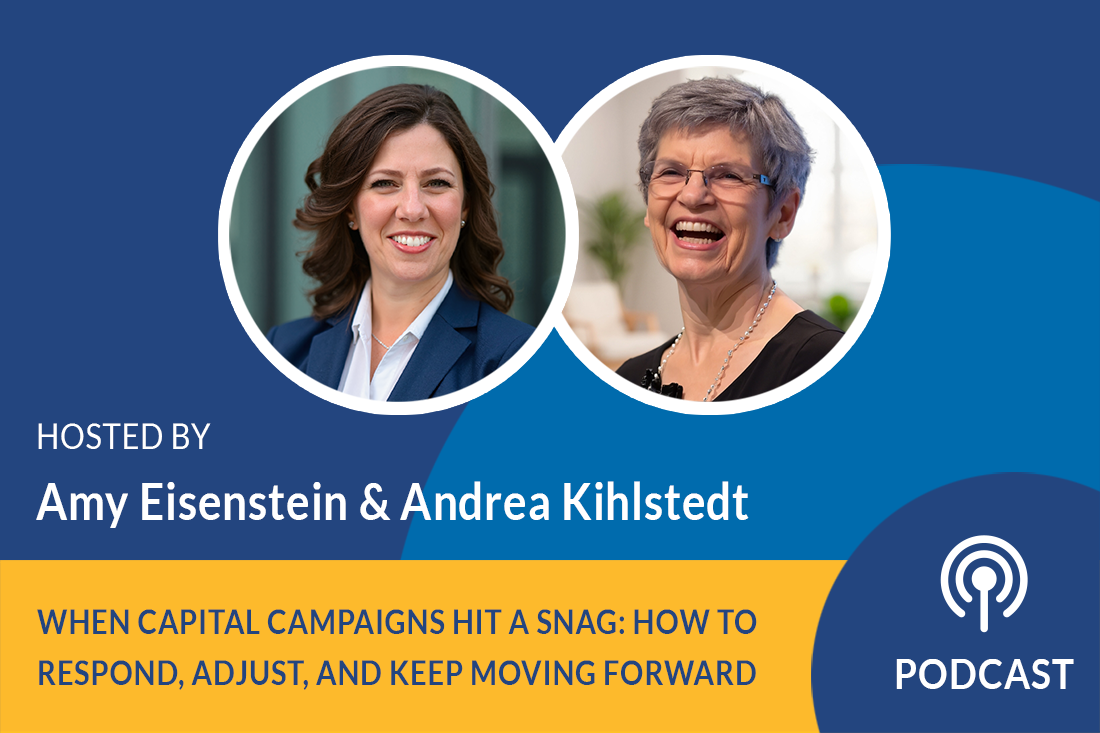Podcast: What 2 Years of COVID Has Taught Us about Fundraising

Season 2, Episode 30
In this episode, capital campaign experts Amy Eisenstein and Andrea Kihlstedt discuss the ten important lessons they’ve learned about fundraising during the brave new world of Covid19. Join them for an uplifting reminder that when times get bad, donors often become more generous!
Listen Now:
This episode was recorded as part of a live webinar held Monday, March 14, 2022. To participate in future webinars, register at ToolkitTalks.com.
Amy Eisenstein:
Andrea, today’s official topic is 10 lessons learned after two years… Can you believe it is the two year anniversary of fundraising with COVID? I mean, it is really, really hard to believe, but we’ve identified 10 lessons learned that we’re going to talk about. I will kick us off. The first one is hope for the best and prepare for the worst. To me, that means having an A plan, which is really your vision.
If you’re thinking about doing a capital campaign, that’s what you plan for. Hope for the best, but plan for the best, and also prepare for the worst. You have B and C plans too in case your A plan doesn’t come through. It’s not the end of the world. What’s another one?
Andrea Kihlstedt:
I’d just say for that, Amy, that the corollary to that is work on being flexible, work on having flexible mind, right? So that you don’t get yourself stuck in a little box. The sort of fluidity of mind is something that all of us can practice in this hope for the best and prepare for the worst. The more you can flow mentally, the easier that’s going to be for you.
Amy Eisenstein:
Yeah, I think that’s…
Andrea Kihlstedt:Effective meetings are effective meetings no matter how you have them. And ineffective meetings are ineffective meetings, right?
Amy Eisenstein:
That’s right.
Andrea Kihlstedt:
How many lousy meetings have you been to in person, Amy?
Amy Eisenstein:
Tons.
Andrea Kihlstedt:
Tons, right? Tons of them, where you go and you sit and somebody lectures at you or talks to you and nobody has a chance to say anything. And eventually the meeting is over and then you leave and you feel lousy, right? That’s a terrible meeting.
Amy Eisenstein:
Right.
Effective Meetings Matter
Andrea Kihlstedt:
You can do that in person, or you can do it on Zoom. It doesn’t much matter.
Amy Eisenstein:
People would think, oh, that’s worse in Zoom. At least on Zoom, you could be yelling at your kids and checking your email. In person, you’ve wasted your whole time driving there and getting there and having an ineffective meeting. The point is that effective meetings can take place in person or virtually as long as they’re effective meetings and they need to be planned to be as such.
Andrea Kihlstedt:
We can’t leave without giving at least one or two tips about what makes an effective meeting.
Amy Eisenstein:
All right, do it.
Andrea Kihlstedt:
All right, here. To have an effective meeting on Zoom or anywhere, you have to make sure that everyone has an opportunity to talk. Ideally, you should plan the meeting so everyone has a chance to talk early in the meeting. Because if you do plan it that way, it will increase participation throughout the meeting. The best way to do that is not to present a whole lot of stuff and say, “All right, who has anything to say?” The best way to do that is to ask very specific questions and then facilitate the conversation.
You go around the room, or you get one person to call on the next person, who calls on the next person, who calls on the next person. You have to design participation. It’s not just stopping and hoping people will say something. That’s my biggest tip.
Amy Eisenstein:
Yeah, I think that’s so right. Actually the goal should be to have… If the meeting’s not too big, if it’s less than 15 people or so, my goal is always to have everybody speak three times, once at the beginning as an introduction, but asking a specific, creative, thoughtful question that everybody answers, then once in the middle, that you’re actually having a discussion and you want to hear from everybody, and then a final thought from everybody as well.
So that everybody’s paying attention and participating and feeling like there’s a real reason for them to be there. I agree. No just saying, “who has a thought,” because then you get crickets, right?
Andrea Kihlstedt:
Right.
Amy Eisenstein:
All right.
Andrea Kihlstedt:
And that’s what everyone’s afraid of, right? That they’re going to get crickets because they haven’t thought to design it for something else. Okay, three.
Action and Adaptation Reign SupremeM
Amy Eisenstein:
All right. Number three is action and adaptation reign supreme and that means that you’ve got to take action. You can’t have a wait and see attitude, right? At the beginning of COVID, lots of organizational leaders acted, right? They took action. They pivoted. They tried new things. They were on fire. And others really were totally frozen and, figuratively, paralyzed by the situation and had a wait and see, right?
And had all sorts of wait and see attitudes on everything. We’ll wait for our board retreat. We’ll wait for our capital campaign. We’ll wait and they didn’t act and they didn’t adapt, and that was a major problem. All right, number four. What’s number four?
Meet More Often — Quick Meetings Are Useful
Andrea Kihlstedt:
Meet, more, not less. Now, that’s a really interesting one, right? Because whoever imagined we would say meet more, right? Everybody’s trying to get rid of meetings. But in fact, if you have efficient meetings and the meetings are fun and they actually get something done and they’re short and as long as they need to be, when you have something that needs to be decided, that needs to be brainstormed, that needs to be discussed, you can have a meeting. You can have a 15 minute meeting.
You can have a 20-minute meeting. Because of technology, you don’t have to meet for an hour, an hour and a half because people have driven so far to get there. You can have really quick meetings and effective ones.
Amy Eisenstein:
I think not only that, there’s something to the out of sight, out of mind mentality. If you’re not coming into work, the tendency is to just be in a box or in a hole. The point is meet with your donors, outreach to your committees. Don’t cancel committee meetings. Make sure that you have something to say and something to discuss, but definitely keep everybody engaged and share what traumas and troubles you’re going through so that people can participate and help. All right, number five, donors want to help.
I think that we really need to remind ourselves of this sometimes. Because when you have gotten some no’s or people have not been available, everybody’s busy, fundraising can be frustrating. I think that what we’ve seen with COVID and lots of other things that have happened over the past two years, that people really do want to help when you give them that opportunity, when you give them that chance, when you say what you need and what you want and give donors a way to help, they really do want to help.
If you need a reminder of that, I want to give it to you now, donors want to help.
Andrea Kihlstedt:
It’s so funny how easy it is to forget that, isn’t it? I think we talked about this a little last week, that it’s easy to get into the mindset of donor don’t want to give away money. We’re going to bother them somehow. But if you can keep yourself in the understanding that donors want to help, I’ll tell you, it makes a huge difference. To me anyway, just talking personally about my own giving, it almost feels like an imposition when organizations don’t come to me and tell me how I can help. I tend to like to support small organizations.
If I support big ones, that’s a different story, or when I support big ones, but I like supporting small organizations where I know the executive director, I know the people. It’s just my preference. When they don’t come to me and ask me for something specific, then it’s on me to try to figure that out. I feel like, I wish they would come more often, and I’m sure they’re thinking, “Oh, we can’t bother her again.” It’s so wrong.
Amy Eisenstein:
That’s right.
Andrea Kihlstedt:
Right? That’s so wrong.
Amy Eisenstein:
Yes. All right, what’s number six?
Technology is Vital to Fundraising
Andrea Kihlstedt:
Technology is vital. We were talking about video conferencing, but I want to talk about other kinds of technology, because I think we have learned and have been learning how easy it is to do creative, interesting things using video, for example, and posting things and creating videos as a way to thank and to recognize our donors. It used to be that if we wanted to use video, we would have to hire a video company to do a very expensive slick piece.
And now with our greater comfort level with technology, we can use it to do all sorts of things that are fun and lively and engaging and surprising and delightful. I think we want to keep going down that road, right?
Amy Eisenstein:
Yes.
Andrea Kihlstedt:
That’s a special addition to our fundraising toolkit.
Amy Eisenstein:
Yeah, I think that’s absolutely right. All right, we’ve sort of covered this a little bit, but I’m going to say it again, communication is essential. I think that during COVID, it would’ve been so easy. Everybody went home. They packed up their offices. No matter what sector you were working in, unless you were on the front lines and keeping things going, so many people working from home and hiding in their homes to be safe and social distancing and not being able to get together.
Communication could have really fallen apart, and I’m sure it did in many areas. How did you keep the communication going? What changes did you make? I think it’s so important. And fortunately, we have the technology that enabled us to do that.
Andrea Kihlstedt:
Yeah. I think the other thing that happened over COVID was that a lot of people when they were in their houses and not going out, they sort of developed a bunker mentality. You almost become afraid. And to have a nonprofit, someone you know in the nonprofit, reach out to you, I think was really helpful to many people, right? It helped them get over that sense of isolation and…
Amy Eisenstein:
Helplessness.
Andrea Kihlstedt:
Helplessness, right? I think communication played a much bigger role than it usually plays in our fundraising programs or might have played a bigger role if you had taken full advantage of it. Number eight, Amy. That’s yours.
Don’t Assume Donors Won’t Want to Help
Amy Eisenstein:
All right, don’t make assumptions. I think that this is so easy to do, to make assumptions that donors don’t want to help, that they don’t want to talk, that they don’t want to give. Only by asking or communicating and not making an assumption about what a donor will do or can do or can’t do or won’t do or whatever can you find out the truth. Because too often I’ll hear a nonprofit leader say, “Well, so and so, they’re not going to give.” And I’ll say, “Well, have you asked, right? How do you know?” And they’ll say, “Well, I just have a sense of it.”
And then it turns out sometimes they’re right, but sometimes they’re wrong. And that’s what assumptions are, right? I want to make sure that you are not making an assumption about your donors. I’ll just tell a quick story. Two decades ago, I worked at Rutgers University and the biggest donors at Rutgers was this lovely couple who lived in a very modest house and drove the oldest station wagon you’ve ever seen. Now, they had their names on buildings across campus.
But if you looked at their or home or looked at their car, you would think that they were totally average or even on the poorer side. But that was their choice. And if we had made an assumption by seeing what they pulled up in, nobody would’ve ever asked them for more than $10, and yet they of millions to the university. Don’t make assumptions. I guess that goes pre and post COVID too, but I just think it’s… I think in COVID, the assumption was everybody’s having a hard time, which was true, but that doesn’t preclude people from giving and being generous.
The assumption was, don’t ask. At the beginning of COVID, so many organizations made the assumption. “It’s not a good time for a campaign. It’s not a good time to ask,” and what we found was that simply was not true.
Andrea Kihlstedt:
Yeah. TJ has pointed out, and I totally agree, that the… Another funny thing that happened, or I thought it was interesting with COVID, is that because people were in, they didn’t spend money. A lot of people had more money. In fact, nationally, savings account balances went up significantly, right? People had money that they hadn’t seen in their accounts for a whole long time.
They canceled trips. They didn’t go to theater. I mean, I live here in New York. My husband and I go to theater. When we go to theater, we go out to dinner. If I add that up over the course of a year, it’s a pretty penny.
Amy Eisenstein:
It’s thousands of dollars.
Andrea Kihlstedt:
Any of that. It’s thousands of dollars that all stayed in our bank accounts.
Amy Eisenstein:
Yeah.
Andrea Kihlstedt:
I wasn’t alone. That happened a lot, that people all of a sudden had disposable income and the organizations that just kept right on asking found that people gave more.
Amy Eisenstein:
All right, let’s do two more, Andrea. What’s number nine?
There is No Wrong Time
Andrea Kihlstedt:
Yes. Number nine is there is no right time. How about there is no wrong time, Amy?
Amy Eisenstein:
Yes. Maybe it should have been there is no wrong time. Yeah, no, but seriously, people think…
Andrea Kihlstedt:
Both of those things, right?
Amy Eisenstein:
This isn’t the right time to start a campaign. This isn’t the right time to ask a donor for money. What are the other issues with this is the wrong time?
Andrea Kihlstedt:
That’s our fear speaking that it’s the wrong time, right? That’s our anxiety. All the anxieties that come up. I don’t care how long you’re in this business. There’s something in you that is likely to be anxious just before you meet with someone to ask them for money. It’s just us human. I’ve very rarely met people who if you really ask… If they really tell you the truth, they don’t say, “Yeah, there’s something that still gets anxious.” This might be the wrong time is one of those anxiety, isn’t it, Amy?
It’s one of those anxiety triggers of, I can’t ask them now because of this or that or the other thing, right? You just have to walk right through that anxiety. The question is, how do you cope with those anxiety blocks, right? All the things that are the reasons that you can’t be asking for someone for something now.
Take Calculated Risks
Amy Eisenstein:
Yeah. All right, let’s wrap up this discussion today with take calculated risks. And honestly, I think that’s a great one for us to wrap up with because capital campaigns are calculated risks. They are, all of them. They’re big, huge fundraising endeavors, often much bigger than the organization has ever undertaken. But the best capital campaigns, nobody’s winging it. It’s calculated. They’ve researched. They’ve thought it through. They’ve made a plan. They’ve prepared. But the problem is when organizations get stuck at that point and can’t move forward because it’s always somewhat of a risk.
There has to be some element of risk. There’s no guarantees in fundraising. Capital campaigns by nature are risky. The question is, what have you done to mitigate the risk? And can you get over the fear to move ahead?
Andrea Kihlstedt:
Amy and I hear every week, every month, anyway, from people who set up a strategy that with us and essentially what they say is, “We had a donor who wanted to give a big gift and they didn’t want to hire anybody to help with a campaign. We really didn’t know what we were doing.” They just said, “Well, just go ahead,” and the money’s going to come in. And of course, the money didn’t come in, because there were no plans and they didn’t know what they were doing. They call out stuff and they say, “Well, what do we do now? Now we’re stuck.”
It’s always so sad because whatever the reason, whether it was a donor who took outsize power in leadership, or whether it was an executive director who kind of decided just to bull ahead, any time an organization takes on a project that big and doesn’t sit and calculate the risk, doesn’t make effective plans, that’s just foolish foolishness, honestly. That’s just foolishness and it does go awry.
Sometimes you can reset and you can bring it around to success, but sometimes that’s really difficult when you’ve gone too far down the road and everybody thinks the campaign has failed. It’s hard to take that and turn it back around.
Amy Eisenstein:
Yeah. All right, good. We’ve had a really good, robust conversation on these lessons learned at the two year anniversary of COVID. Thank you for that, Andrea, some really good reminders and lessons learned.



Leave a Comment